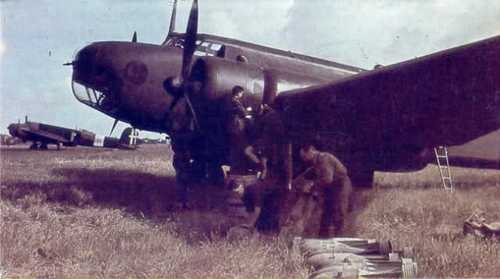
Italian Forces
Malta 1941: the return of the Italian Air Force
IMC Archives
Sicily, Summer 1941: bombs loading on board an all-black Italian bomber BR.20M before a night mission over Malta. Early 1941 the presence of Italian Air Force in Sicily, deployed most all against Malta, were extremely reduced, due to the Regia Aeronautica’s commitment in the Greek Campaign with her place taken by the Luftwaffe’s X. Fliegerkorps (10th Air Corps). On 1st January 1941 the forces of the Italian Air Force’s Comando Aeronautica Sicilia (Sicily Air Command) were, de facto, only the 30th Stormo BT, Savoia-Marchetti S.79, 279th Squadriglia AS, Savoia-Marchetti S.79 (on 7 April 1941 moved to Aegean theatre) and 1st Stormo CT, with six Squadriglie, Fiat CR 42 and Macchi MC.200 (BT=Bombardamento Terrestre/Land Bombardment, AS=Aerosiluranti/Torpedo Aircraft, CT=Caccia Terrestre/Land Fighter). A force in the eyes of war’s perspective nearly unimportant and in effect from January to May 1941 the air offensive against Malta was only committed to German air forces. However during the first five months of 1941 the Italian Sicily Air Command’s forces was gradually implemented with: arrival, 26 January, of the 156th Gruppo CT, CR.42 (1st April integrated in the 22th Gruppo returned from Libya), establishment, 16 February, of the 278th Squadriglia AS, S.79 torpedo bombers, arrival, 25 April, of the 10th Stormo BT, S.79, arrival, 7 May, of the 99th Gruppo of the 43rd Stormo BT, Fiat BR.20M (de facto first massive appearance of this twin engine medium bomber for the air offensive against Malta). In this months the foremost commitment of the Italian aircrafts, excepted few sorties over Malta together the Luftwaffe’s forces most all escort missions, was the protection of the air and maritime traffic to Libya and, for the fighters, air defence of the Sicily and the island’s bases against the increasing British raids. The situation changed totally when, from 1st June 1941, the 10th German Air Corps moved from Sicily to Greece and was replaced by the Italian air units which, until 30 November, took the complete responsibility of the air offensive against Malta plus other commitment as the attack of the British ship and convoys. Contextually the Sicily Air Command was notably reinforced with the arrival, besides of the other units already on the Island: June 31st Gruppo BT, BR.20M added to 99th Gruppo, both under 43rd Stormo (moved on October and replaced by the 37th Stormo), 101st Gruppo BaT (Bombardamento a Tuffo/Dive Bombardment), Junkers Ju 87B&R, 10th Gruppo of the 4th Stormo CT, MC.200, 54th Stormo CT, MC.200, on replacement of 1st Stormo; July: 173rd Squadriglia RS (Ricognizione Strategica/Strategic Reconnaissance), Fiat CR.25, plus establishment of the 282nd Squadriglia AS, Savoia-Marchetti SM.84 (first appearance in Sicily of this new bomber/torpedo aircraft), and 377th Squadriglia aggregated to 23rd Gruppo CT, Reggiane Re.2000 (first appearance in Sicily of this fighter aircraft); September: 9th Stormo BT, CRDA Cant-Z-1007bis on replacement of the 30th Stormo, 9th Gruppo CT, Macchi MC.202 (first appearance in the air offensive against Malta of this modern fighter), added to 10th Gruppo of the 4st Stormo; October: 37th Stormo BT, BR.20M, on replacement of the 43rd Stormo and establishment of the 171st Gruppo CN (CN=Caccia Notturna/Night Fighter) Fiat CR.42CN. On the month of November the Luftwaffe returned in Sicily with the newly established II.Fliegerkorps (2nd Air Corps) and in the same time began the reduction of the Aeronautica Sicilia’s forces, replaced by the German, moving many units to other fronts. Late December 1941 the only air units of the Sicily Air Command deployed on the Island were 9th Stormo BT, 10th Stormo BT, 278th Squadriglia AS, 282nd Squadriglia AS, 54th Stormo CT, 282nd Squadriglia, 173nd Squadriglia RS plus Nuclei CN (Night Fighter Team) with the CR.42CN. From 1st January to 31 December 1941 the units of the Comando Aeronautica Sicilia make a total of 16,433 sorties: Bombers 3,580 (782 over Malta), bombs dropped kg 441,000, flight/hours 10,530; Dive bombers 131 (64 over Malta), bombs kg 33,000, flight/hours 351; Torpedo bombers aircraft 189 (5 over Malta with special bombs), flight/hours 585, dropped 32 torpedo and 5,000 kg of bombs; Fighters 12,398 (1,909 over Malta for escort, recce, strafing) flight/hours 18,110; Strategic Reconnaissance 135, flight/hours 393. Total loss 70 aircraft: Bombers 27; Dive bombers 3; Torpedo aircraft 2; Fighters 38. Crew loss total: KIA/MIA 193 + 44 wounded (maximum crew loss, 135 KIA/MIA, in the bombers units). In the same time the Luftwaffe’s loss was 81 aircraft with the maximum in the bombers/dive bombers units (33 Ju 88, 29 Ju 87 and 10 He 111). Victor Sierra
3751 Views
2/2/2013
